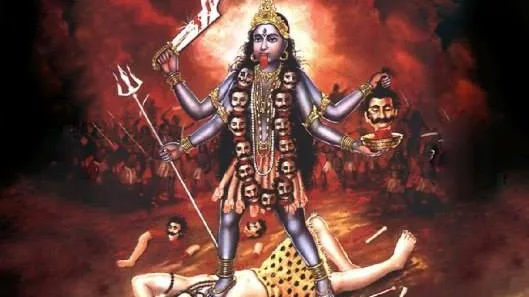In the name of the one hundred virgins from the ineffable mystery that is hidden in the depth of all ages, it is now important to talk a little about the famous Hindustani Papapurusha (the ‘I’).
The old hermits from the sacred land of Ganges have the custom of mentally visualizing it in the left side of the cavity of the stomach and it having the size of the thumb. They imagine it with a wild aspect, red colored eyes and beard, holding sword and shield with its shirring forehead. This symbolical figure represents any of our psychological defects…
Mystical, unforgettable moment of exotic oriental beatitude is the one in which the anchorite Elders chant their sacred Mantras and concentrate themselves ecstatically in the region of their navel…

In those delectable moments of unsuspected joy, the Yogi must think in the Papapurusha, imagining it being reduced into ashes within the crackling fire.
Tears of profound repentance for the deeds committed in ancient times fall from the eyes of the penitent one, who in holy silence beseeches his Divine Mother Kundalini to eliminate from his interior this or that psychological defect.
This is, indeed, how the Sadhaka is dying from moment to moment. What is new arrives only with death…
The Papapurusha is the Lunar Ego, Goethe’s Mephistopheles, the dreadful Klingsor from the Wagnerian drama…
The terrible fact is by all means evident that the Papapurusha does not have a legitimate individuality, it is not a unique center of command, it is not a particular ray…
Each idea, any sentiment, this or that sensation, ‘I love’, ‘I do not love’, is without a doubt a different, distinct ‘I’…
These multiple ‘I’s are neither joined amongst themselves, nor are they coordinated in any way. Each one of them certainly depends upon the diverse exterior changes…
Any given ‘I’ fatally follows another, and some of them even give to themselves the luxury of appearing accompanied by others. Nonetheless, it is obvious that there is neither an order nor a system in this.
Some capricious groups of quarrelsome and shouting ‘I’s have amongst themselves certain psychic ties, constituted by natural associations of a completely accidental type: fortuitous remembrances or special similarities.
It is ostensible that each one of these fractions of the Papapurusha, each one of these psychic aggregates or ‘l’s represent, in any given moment, only a most inferior part of all our psychological functions. Nevertheless, it is unquestionable that any particular type of ‘I’ believes very sincerely that it is representing the whole…
When the wretched intellectual animal mistakenly called human says “I” he has the false impression that he is talking of himself in his total, integral aspect. But indeed, it is any one of the innumerable subjective fractions of his Papapurusha that is speaking.
Moments later, he can totally forget it, and express with identical conviction any other antithetical idea, a simple manifestation of another ‘I’.
The multiple contradictions of a psychological type have as a foundation the Pluralized ‘I’, which are the various phases of the Papapurusha.

The grave aspect of all of these psychological processes is that the wretched rational humanoid certainly does not remember anything about these things. In the majority of cases, he gives his reputation to the last ‘I’ that has spoken. This will be for as long as such an I’ endures, that is to say, until a new ‘I’, which sometimes without any relation with the anterior one, expresses another strong opinion.
It is certain that the consciousness, bottled up inside all of those subjective fractions of the Papapurusha, sleeps profoundly. It is subconsciousness…
We need to convert the subconsciousness into consciousness, and this is only possible by annihilating the Papapurusha…
So, in order to conclude with this chapter, it is important to analyze some very interesting words in Sanskrit; let us see:
AHMKRITA BHAVA: The meaning of these two Hindustani terms is egoic condition of our own consciousness.
It is obvious that the consciousness inserted into all of those psychological aggregates that constitute the Papapurusha fatally processes itself in accordance to its own bottled condition.
ATMAVIDYA: This is a mysterious word, a Sanskrit term filled with a deep significance. This must be translated as awakened consciousness freed from the Papapurusha, by means of the total annihilation of the latter one.
It is notorious that the consciousness, bottled up inside all of those subjective elements of the Papapurusha, does not enjoy authentic illumination. It is found in the state of millenary somnolence. It sleeps, it is always a victim of Maya (illusions).
ATMASHAKTI: This is a divine Sanskrit term. We point, indicate absolute spiritual power with this golden word.
As a result, consequence or corollary, we can and even must emphasize the classic idea that the consciousness cannot enjoy legitimate spiritual power while it is not yet integrally liberated from its Egoic condition.
The Wagnerian Parsifal, protected with the weapons of Vulcan, reduced into cosmic dust the monster of one thousand phases, the famous Papapurusha. Thus, only in this way did he re-conquer the innocence in his mind and heart.
If indeed it is true that in a remote past the son of Herzeleide had mortally wounded the Kala Hamsa Swan, it is ostensible (and anybody can comprehend this) that when he entered into the lands of Monsalvat, lust no longer existed inside of him. He was pure, he had converted himself into a Saint, he had attained the ATMA VIDYA.
Samael Aun Weor
Subscribe to our news, promotions and getting started lessons!



